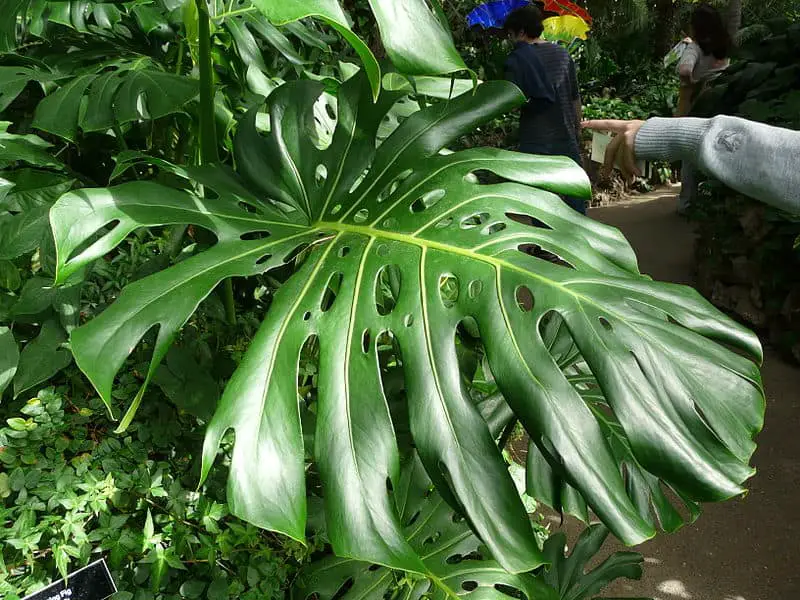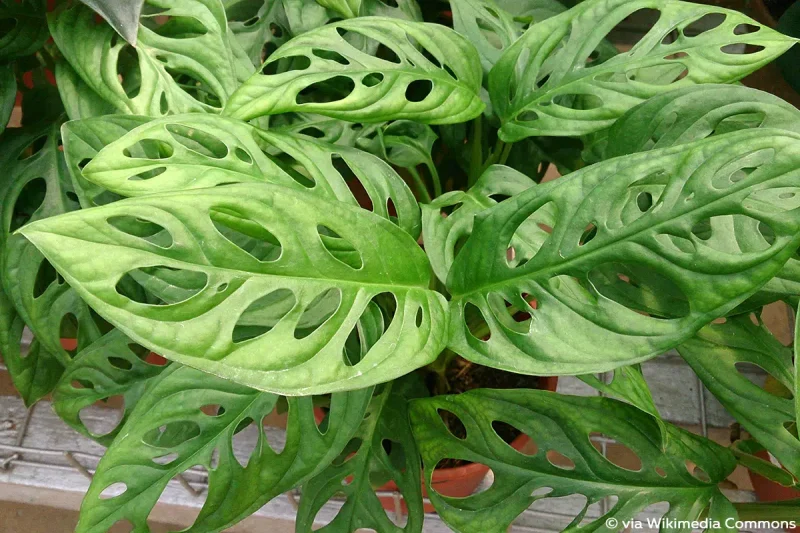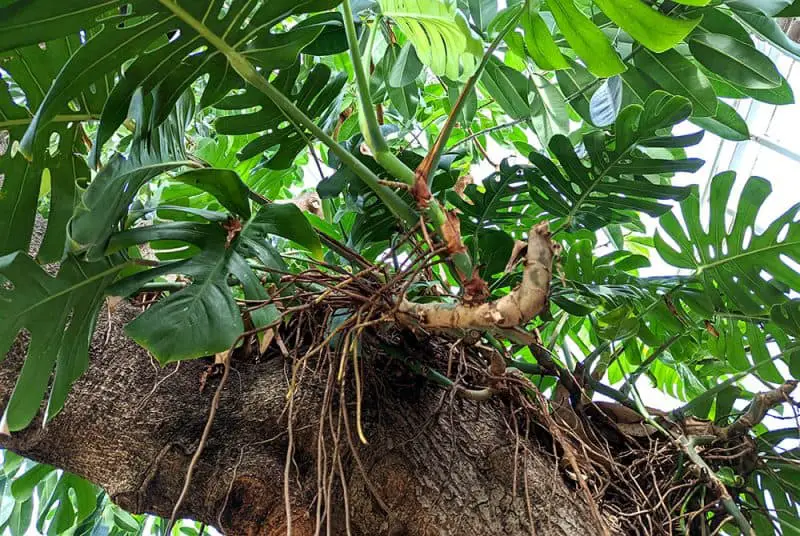This post contains affiliate links. If you buy something from one of our links we may earn a commission. Thanks

Do you have a Swiss cheese plant that you don’t know how to care for? Are you afraid that you will kill it if you don’t water it enough?
Don’t worry, we are here to help. In this blog post, we will discuss how to care for a Swiss cheese plant so that it stays healthy and happy.
Swiss Cheese Plant Care Key Takeaways:
- Swiss Cheese Plant Care involves placing the plant in bright, indirect light.
- Watering it when the top inch of soil is dry.
- Feeding it with a half-strength balanced fertilizer once a month during the growing season.
- Ensuring high humidity, proper drainage, and occasional pruning will keep your Swiss Cheese Plant healthy and thriving.
What Is A Swiss Cheese Plant?
Monstera deliciosa, the Swiss cheese plant or split-leaf philodendron is a species of flowering plant native to tropical forests of southern Mexico, south to Panama… It is very widely grown in temperate zones as a houseplant. The common name “Swiss cheese plant” is also used for the related species from the same genus, Monstera adansonii. https://en.wikipedia.org/wiki/Monstera_deliciosa
What Kind Of Swiss Cheese Plant Do I Have?
The picture above is Monstera Deliciosa while the one below is Monstera Adonsii.
There is a plant called Rhaphidophora tetrasperma that is sold as a mini Monstera that looks similar but is a different plant entirely.
As you can see below although this Monstera Adonsii has similarities the leaves are very different.
They are closely related but different plants. The Monstera Adonsii is a smaller plant and more vinelike.
The leaves have more holes and the margins are smooth and not lobed like Monstera Deliciosa.
Monstera plants are very popular houseplants because of their large size and the fact they are easy to grow.
They recently became popularized on Instagram too. Generally speaking, you will pay more for the Deliciosa than the Adonsonii or the mini Monstera.

How To Care For A Swiss Cheese Plant In A Nutshell
The Swiss cheese plant (Monstera deliciosa) is a tropical evergreen that gets its common name from its large, perforated leaves.
It’s native to the rainforests of Central and South America, where it grows as an understory plant.
In its natural habitat, the Swiss cheese plant can reach heights of up to 30 feet, but it is often much smaller when grown in pots.
Swiss cheese plants are relatively easy to care for, and they make an excellent addition to any indoor jungle.
Here are a few tips for keeping your Swiss cheese plant healthy and happy:
Light: Swiss cheese plants do best in bright, indirect light. They can tolerate some direct sun, but too much sun will scorch their leaves.
Water: Water your Swiss cheese plant when the top inch or two of the soil is dry. Allow the water to run through the pot and drain out the bottom. Avoid letting the plant sit in water, as this can lead to root rot.
Fertilizer: Feed your Swiss cheese plant once a month during the growing season with a half-strength fertilizer solution. Be sure to flush the pot with clean water after applying fertilizer to prevent root burn.
Humidity: Swiss cheese plants prefer high humidity, so mist them regularly or set them on a pebble tray.
Temperature: These tropical plants like it warm, so aim for temperatures between 65 and 80 degrees Fahrenheit.
Pruning: Prune your Swiss cheese plant to shape it or remove damaged leaves. Use sharp, clean shears and make cuts just above a leaf node.
Now that you know how to care for your Swiss cheese plant, there’s nothing stopping you from enjoying this beautiful indoor jungle plant in your home.
Just be sure to give it the proper care and attention, and it will thrive for years to come.
Propagating The Swiss Cheese Plant
The Swiss cheese plant, also known as the Monstera deliciosa, is a popular houseplant that is easy to care for and propagates easily from stem cuttings.
To take a stem cutting, simply cut a portion of the stem that includes at least two leaves.
Place the cutting in a glass of water and allow it to root for several weeks.
Once the roots are well-established, you can pot the plant in soil.
The Swiss cheese plant does best in bright, indirect light and prefers to be on the moist side.
Even so, it’s a good idea to let the soil dry out between waterings to avoid overwatering.
With a little care, your stem cutting will quickly grow into a healthy new Swiss cheese plant.
How To Prune Your Swiss Cheese Plant
The Swiss cheese plant, also known as the Monstera deliciosa, is a beloved houseplant for its large, glossy leaves.
However, over time, these leaves can start to lose their luster and develop brown spots.
One way to help keep your Swiss cheese plant looking its best is to prune it regularly.
Pruning helps to encourage new growth and removes any dead or damaged leaves.
It’s best to prune in the spring or summer when the plant is actively growing.
To prune your Swiss cheese plant, simply cut off any yellowed or brown leaves at the base of the plant.
You can also trim back any long vines to tidy up the plant’s shape.
This plant can get quite large even indoors in a pot so pruning may be needed just to keep its size in check.
With a little bit of care, you can keep your Swiss cheese plant looking healthy and beautiful for years to come.
Swiss Cheese Plant Aerial Roots

The Swiss Cheese Plant can make aerial roots. It uses these to climb. You can attach a pole to your plant and it will climb up it.
The Monstera Adonsonii is more vinelike than the Deliciosa and is a climber but both types will try to climb eventually.
The Swiss cheese plant (Monstera deliciosa) is a popular houseplant known for its large, glossy leaves.
However, the plant is also notable for its aerial roots, which help it to climb and cling to surfaces.
These roots are thinner and more flexible than the plant’s regular roots, and they help them to grip surfaces.
The Swiss cheese plant typically only produces aerial roots when it is growing in an environment that doesn’t provide enough support, such as a pot.
However, in many cases, the plant may produce aerial roots even when it is adequately supported.
If you notice your Swiss cheese plant producing aerial roots, simply allow them to grow freely or gently guide them into a pot or support structure.
If you really don’t like the look of them you can prune them off your plant.
Is The Swiss Cheese Plant Poisonous To Cats And Dogs?
Yes unfortunately the Swiss Cheese plant is poisonous to cats and dogs according to the ASPCA.
Additional Common Names: Cutleaf Philodendron, Hurricane Plant, Ceriman, Mexican Breadfruit
Scientific Name: Monstera deliciosaFamily: AraceaeToxicity: Toxic to Dogs, Toxic to CatsToxic Principles: Insoluble calcium oxalates
Clinical Signs: Oral irritation, intense burning and irritation of mouth, tongue and lips, excessive drooling, vomiting, difficulty swallowing. Swiss Cheese Plant | ASPCA
Swiss Cheese Plant Care FAQs:
Taking care of a Swiss Cheese Plant (Monstera deliciosa) is a rewarding experience as this tropical native transforms indoor spaces with its unique foliage.
Though known for their ease of care, understanding their basic requirements is key to a thriving Monstera.
This guide answers some common questions about Swiss Cheese Plant care, ensuring you have all the information to keep your plant healthy and vibrant.
Q. How often should I water my Swiss Cheese Plant?
A. Water your plant when the top inch or two of soil is dry. Usually, watering once a week is sufficient, but it may vary based on the humidity and temperature of your home.
Q. What kind of light does a Swiss Cheese Plant need?
A. Swiss Cheese Plants prefer bright, indirect light, though they can tolerate lower light levels. Avoid direct sunlight as it can scorch the leaves.
Q. How to fertilize a Swiss Cheese Plant?
A. Feed your plant once a month during the growing season with a half-strength balanced fertilizer. Be sure to flush the soil with water to prevent fertilizer buildup.
Q. Is repotting necessary for Swiss Cheese Plants?
A. Yes, repotting every 12-18 months or when you see roots growing out of the drainage holes is advisable to provide fresh nutrients and more space for growth.
By understanding and meeting the basic needs of your Swiss Cheese Plant, you ensure a lush and thriving addition to your indoor garden.
How To Care For A Swiss Cheese Plant Final Thoughts
If you’re looking for an easy-to-care-for houseplant that will purify the air in your home the Swiss Cheese Plant (or Monstera Deliciosa) is a great option.
While it does require some basic upkeep, such as regular watering and the occasional pruning, the Swiss Cheese Plant is generally low-maintenance.
It can grow quite large. A mature Monstera can reach approximately eight feet in height and produce leaves that are up to two feet wide.
So if you are after a jungle effect this is the plant for you.
And, as an added bonus, it can even help to boost your mood and creativity. So if you’re looking for a plant that’s both stylish and functional, the Swiss Cheese Plant is a great choice.
Read More: Swiss Cheese Plant Questions
If you are not sure about the benefits of keeping houseplants this article can help:
Benefits Of Keeping Indoor Plants For Improved Lifestyle (indoorvegetablegrower.com)







